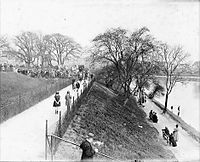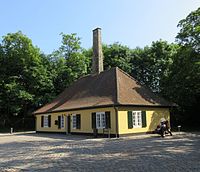Christianshavns Vold
| Christianshavns Vold | |
|---|---|
 Christianshavns Vold andStadsgravenviewed from the top of Hotel Radison Scandinavia | |
| Type | Public park and historic site |
| Location | Christianshavn,Copenhagen |
| Coordinates | 55°40′25″N12°36′13″E/ 55.6735°N 12.6035°E |
| Area | Land: 12 ha/Water: 19 ha[1]
+Christianiaportion |
| Created | 1918–25 |
Christianshavns Voldis a formerrampartwhich was part of thebastioned fortification ringwhich used to surroundCopenhagen,Denmark.Running along the full south-eastern perimeter of Christianshavn andHolmen,it used to form a protective barrier towards the island ofAmager.It consists ofearthworkswith 12bastionsand in front of it ran amoat,Stadsgraven,now forming a broad canal which separates Christianshavn from the rest of Amager. On the other side of Stadsgraven. on Amager, was a lower system ofoutworkscalledChristianshavns Enveloppeof which only the northern half survives. Along withKastelleton the other side of the harbour, it is the only intact part of the fortification system.
Today Christianshavns Vold serves as an importantgreenspaceforChristianshavn's inhabitants. The southern half of the rampart is a municipal park whereas the northern portion is part ofFreetown Christiania,a self-built, semi-autonomous community which has existed since the early 1970s. Part of Christiania is located on the far side of Stadsgraven and the two halves are connected by theDyssebroenfootbridge.
History
[edit]
As part of his endeavour to modernize Copenhagen's fortifications,Christian IVconstructedChristianshavnas a fortified merchant's town at a shallow-watered, marshy area north ofAmagerto complete a fortification ring around Copenhagen. The town was laid out with low earthworks facingAmager.The rampart was constructed with four and a half bastions and a city gate, known as Amagerport, through which all traffic to and from Amager had to pass.[2]

In the 1670s, when Vestervold was extended to reach the sea, Christiansvold was moved and extended to match the new course of Vestervold. Only the two northernmost bastions, today known as Løvens Bastion and Elefantens Bastion, remained on their original location. The new Christianshavns Vold had five very large bastions. Around the entire complex was a moat with a protectingcounterscarp.From 1682 to 1692 Christianshavns Vold was again extended this time in northwards, to guard the entrance to the harbour and protect the new base for the Royal Fleet at what was to become known asNyholm.The extension included seven new bastions, named for members of the royal family. The last extension of Christianshavns Vold was constructed as late as 1878–82, when a rampart was constructed along the eastside of the newly reclaimed Refshaleø.
Bastions
[edit]
Kalvebod Bastion
[edit]
Kalvebod Bastion takes its name afterKalveboderne,the shallow waters which were located to the south of Copenhagen in what is now itsSouthern Docklands.The bastion contains two buildings. Magasinbygningen, the larger of the two, is a two-storey, L-shaped storage building from 1800. The other one is a small forge from 1757. Both are today owned byKarberghus,a privately owned property which mainly invests in historic properties.[3]
Enhjørningens Bastion
[edit]

Enhjørningens Bastion (The Unicorn's Bastion) dates from 1668 to 1670. The bastion contains a gunpowder magazine from c. 1675 which was formerly used as a storage space by Copenhagen Municipality's park authority.[4]It now serves as club house for Qajaq København, a kayak club.[5]
A windmill was first constructed on the bastion in 1683. It was destroyed by fire in the 1750s but replaced by a new one in the 1770s. A combined distillery and tavern—frequentved by the many Dyrch farmers from Amager who came to Copenhagen on market days to sell their produce onAmagertorv—was also located on the site. In the late 18th century, Peter Rabe Holm constructed asmall beerbrewery on the site. In the 1850s, it was replaced by a new, industrial brewery still known as Rabeshave ( "Rabe's Garden" ) after the site's former owner. In the 1890s, Tabeshave merged with 11 other breweries as De Forenede Bryggerier. In 1907–1919, J. Wiedemann constructed a sausage factory on the site. It has now been converted into a multi-tenant office complex (Æangebrogade 6). The adjacent double house from 1802 to 1914 was listed in the Danish registry of protected buildings and places in 1988.
Panterens Bastio
[edit]
Panterens Bastion (The Panther's Bastion) contains a former military training facility for shooting with hand guns. The buildings, a complex of red brick buildings, has now been converted into apartments.[6]An unnamed footbridge connects the bastion to Amager Boulevard on the other side of Stadsgraven.
Elefantens Bastion
[edit]Elefantens Bastion (The Elephant's Bastion) is located just south of Torvegade. It replaced Møllebastionen (The Mill Bastion) in 1667–70. A windmill, Breslaus Mølle, stood on the bastion from 1670 to 1842.[4]
Løvens Bastion
[edit]Løvens Bastion (The Lion's Bastion) is located a little north of Torvegade. The bastion is home toLille Mølle,a smock mill which replaced an older stub mill in 1783. The mill cap was removed in 1897 and it was later converted into a private residence. It was taken over byNational Museumin the early 1970s and is now operated as a historic house museum. An adjacent building contains the restaurant Løven + Bastionen.[4]
Ulrichs Bastion
[edit]Ulriks Bastion (Ulrik's Bastion) dates from 1682 to 1692. It was named afterUlrik Christian Gyldenløve,a son of Christian V andSophie Amalie Moth.It was used by Søetatens Laboratorium and became part of Bådsmandsgade Barracks in the 1830s. It has been part of Christiania since 1971.
Sophie Hedvigs Bastion
[edit]Sophie Hedvigs Bastion dates from 1682 to 1692. It received its name afterPrincess Sophia Hedwig,a daughter of Christian V byQueenCharlotte Amalie.It contained a gunpowder mill from 1687 to 1750 and then an oil mill until it became part of Bådmandsgade Barracks in the 1830s. It is now part of Christiania. The footbridgeDyssebroenconnects the bastion to Dyssen on the other side of Stadsgraven.[4]
Vilhelms Bastion
[edit]Vilhelms Bastion dates from 1682. It received its name afterPrince William of Denmark,a son of Christian V by Queen Charlotte Amalie. The bastion contains a gunpowder magazine from 1688. It was designed byHans van Steenwinckel the Youngest.A half-timbered building was constructed next to it in 1690.
Carls Bastion
[edit]Carls Bastion (Charles' Bastion) dates from the years after 1682. It was named afterPrince Charles,a son of Christian V by Queen Charlotte Amalie. The bastion contains a gunpowder magazine from 1690. It was designed byHans van Steenwinckel the Youngest.
Frederiks Bastion
[edit]
Frederiks Bastion (Frederik's Bastion) dates from the years after 1682. It was named afterCrown Prince Frederick,Christian V's son by Queen Charlotte Amalie, who succeed him in 1744–45. The bastion contains a gunpowder magazine from 1690. It was designed by C.E.D. von Øtken. The building, which is known simply as Frederiks Bastion, is used as a venue for exhibitions, concerts, workshops, meetings and other events.[7]
Charlotte Amalies Bastion
[edit]Charlotte Amalies Bastion is located just north of Refshalevej. It dates from the years after 1682 and is named after Charlotte Amalie, Christian V's queen. Restaurant 56° is located in a former gunpowder magazine.[8]The gunpowder magazine is from 1744 to 1745. It was designed by C.E.D. von Øtken.
Quintus Bastion
[edit]Quintus Bastion or Christiani Quinti Bastion dates from the years after 1682. It was named after Christian V. It became part of the Nyholm Dockyards in the 1770s. In 1858, it became home to the storage facility Søbefæstningens Materialgård. Galf of the bastion was made available to Søminekorpset in the 1870s, and several buildings were subsequently built at the site.
Christianshavns Vold today
[edit]Christianshavns Vold generally remains well-preserved as ahistoric site.Torvegade, the main thoroughfare of Christianshavn, running fromKnippels Bridgeto the dam to Amager, passes between Løvens Bastion and Elefantens Bastion at the site where Amagerport used to lie. The grounds serve as apublic park,part of the city'sFortification Ringpark band. The windmill on Løvens Bastion,Lille Møllewhich was converted into a private home in 1917, has been converted into ahistoric house museum.[9]
The northern part of the rampart is today part ofFreetown Christiania.The two formergunpowdermagazines at Frederiks and Carls Bastions serve as venues for small concerts and art exhibitions.[10]
Public art and memorials
[edit]On the Lion's Bastion stands a memorial to the writerMartin Andersen Nexøwho was born in nearbySankt Annæ Gade.The work, a bronze torso on a granite plinth, was created byKnud Nellemose.On the Panther's Bastion stands another memorial. It depicts Christians Holm, one of the driving forces behind the preservation of Christianshavns Vold.[11]
See also
[edit]- Fortifications of Copenhagen (17th century)
- Fortification Ring, Copenhagen
- Parks and open spaces in Copenhagen
References
[edit]- ^"Fakta/historie".Københavns Kommune.Retrieved2010-07-03.[dead link]
- ^"De bastionære fæstninger 1600-1870".Selskabet for Københavns Historie. Archived fromthe originalon 2013-09-21.Retrieved2009-11-17.
- ^"Langebrogade 4".indenforvoldene.dk(in Danish). Archived fromthe originalon 2 February 2017.Retrieved18 January2017.
- ^abcd"Befæstningsleksikon 1600-1870"(in Danish). Selskabet for Københavns Historie. Archived fromthe originalon 2011-07-19.Retrieved18 January2017.
- ^"Klublokaleril"(in Danish). Qajaq København.Retrieved17 January2017.
- ^"Panterens Bastion".Ejerforeningen Panterens Bastion(in Danish).Retrieved18 January2017.
- ^"Frederiks Bastion"(in Danish). Frederiks Bastion.Retrieved18 January2017.
- ^"56°".aok.dk(in Danish). Archived fromthe originalon 16 February 2021.Retrieved18 January2017.
- ^"Løvens Bastion".Christianshavns Lokalhistoriske Forening & Arkiv.Retrieved2009-11-17.
- ^"Christianshavn".Wonderful Copenhagen. Archived fromthe originalon 2010-03-23.Retrieved2009-11-17.
- ^"Christianshavns Vold med monumenter og mindesmærker m.m. - på begge sider ad volden".grandts.dk(in Danish).Retrieved29 January2017.

